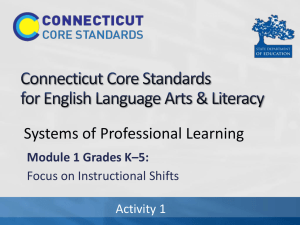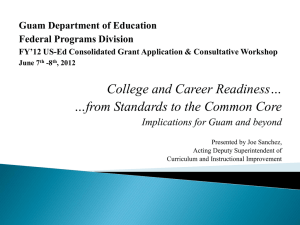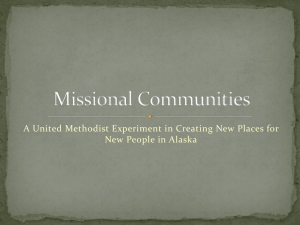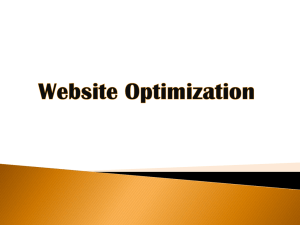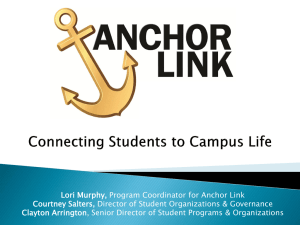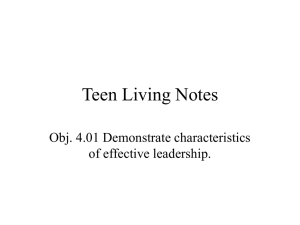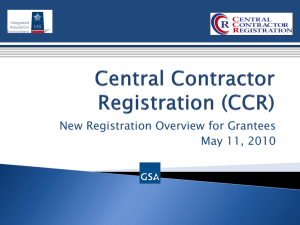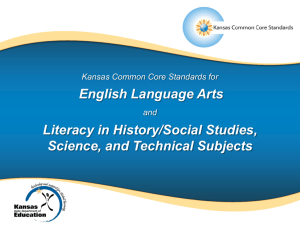CommonCoreBasicsPowerPoint - Your Contemporary Rep Maxine
advertisement
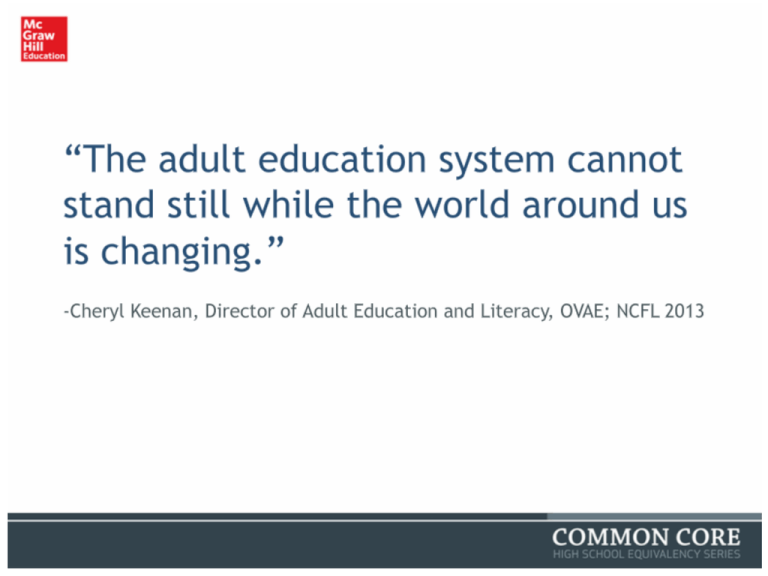
Nearly 4 million middle-skill jobs are unfilled today because there aren’t enough people with the right skills and education. To bridge that gap, high school equivalency expectations, and thus the exams, must evolve to align with the critical skills and knowledge adults need to get these jobs—skills aligned with the College & Career Readiness Standards for Adult Education. CHALLENGE 1: • Increased rigor and depth of knowledge expectations for students, as well as an instructional shift for teachers CHALLENGE 2: • Multiple high school equivalency exam options for the first time in history CHALLENGE 3: • Greater focus on college and career readiness beyond simply passing the test The Common Core Shift The Common Core State Standards are the basis for high school equivalency assessments currently under development. Clear and purposeful instruction depends on clear and precise standards, which are provided by the Common Core State Standards for both English Language Arts and Mathematics. The standards reflect what students need to learn if they are to be prepared for the post-secondary world, and also form the “core” of the College and Career Readiness Standards for Adult Education. The Common Core Shift The US Department of Education (US DoE) identifies a single goal for all students: they should attain skills and knowledge that prepare them for college and choices of careers. Students in adult education programs are no exception. Toward that end, the DoE and the Office of Vocational and Adult Education (OVAE) have developed rigorous instructional standards that support college- and career-readiness. These are the College and Career Readiness Standards for Adult Education. (handouts Ready/Language/Writing CCR Anchor Skills and Mathematics CCR Reference) Your Solution for CCSS / CCR Success To prepare students for these equivalency tests, McGraw-Hill's Common Core Basics: Building Essential Test Readiness Skills focuses explicit instruction on the foundational skills and practices presented in these standards, along with higher-order thinking skills that prepare students to achieve college and career success. Core Subject Modules Reading Writing Mathematics Science Social Studies A Focus on Readiness: Core Skills and Practices READING Reading- Lesson 1.4, page 40 Core Skill Summarize Information When you summarize information from a text, you briefly state the text’s main points. Summaries do not include personal opinions or information that was not part of the text. Writing a summary will help you understand and remember the text. As you read, look for the main idea in each paragraph or section. Watch for places where the author has repeated certain ideas. When you have finished reading, you will be able to write a summary statement that answers this question: What does the author want you to understand and remember? The process for summarizing information in workplace documents is the same as summarizing other nonfiction texts. As you read the job description on this page, think about the information in each section. What does the author want you to understand about this job? What are the most important parts of the job? Make a chart like the one below to record your summary. A Focus on Readiness: Core Skills and Practices WRITING Writing- Lesson 2.1, page 48 Reading Skill Use Context Clues Context clues are words that provide hints about a sentence’s meaning. Verbs can provide some information about whether an event is in the past, present, or future, but sometimes that is not enough. In those cases, other words, such as before, yesterday, and next week, can help make your writing clear and provide clues for readers. In the following sentence, the word tomorrow and the verb will are clues that the party will take place in the future. Tomorrow she will purchase the cake for the party. Write three sentences to tell about something that happened in the past, is happening in the present, and will happen in the future. Include context clues, such as the words yesterday, every morning, and next year. A Focus on Readiness: Core Skills and Practices MATHEMATICS Mathematics- Lesson 1.7, page 41 Core Practice Attend to Precision Precision is important in mathematics, engineering, and sciences. One of the purposes of making multiple measurements or repeating experimental trials is to find precise answers, or answers that repeat the same value. You may have heard someone say, "Measure twice, cut once," while undertaking a construction project. What is the purpose of measuring twice? And is twice enough? When builders measure multiple times before they saw a length of wood, for example, they are attending to precision. If multiple measures result in the same value, builders can be confident that the value is precise. In your notebook, describe a time you made multiple measurements or repeated the steps of an experiment to check mathematical values. Explain the value of precision in your work. A Focus on Readiness: Core Skills and Practices SCIENCE Science- Lesson 3.4, page 114 Core Skill Cite Textual Evidence The International Union for Conservation of Nature and Natural Resources (IUCN) has produced the Red List of Threatened Species™. A threatened species remains abundant but is likely to become endangered, or on the verge of extinction, if not protected. Currently, the IUCN identifies habitat loss as the main threat to 85 percent of threatened and endangered species on the list. Cite the textual evidence from this lesson that most strongly supports their conclusion. To do this, first reread the lesson text, and then look for page numbers and paragraphs where information on threatened and endangered species can be found. Then, when you find the information, highlight it, put a star next to it, or circle it. A Focus on Readiness: Core Skills and Practices SOCIAL STUDIES Social Studies-Lesson1.5, page 46 Reading Skill Synthesize Ideas from Multiple Sources Reading more than one source about a topic can broaden your understanding and spark new ideas. Different sources may offer varying viewpoints and more information. When you synthesize, you blend ideas from two or more sources. Combining ideas gives you a fuller understanding of a topic. Choose a “third party” that you would like to know more about. Find several sources of information about this topic— including multimedia sources available on the Internet. Take notes as you read. In your notebook, write one paragraph in which you synthesize the ideas you have found. 21ST Century Skills The Partnership for 21st Century Skills, is a national organization with a single aim—to prepare every student for work and learning in the 21st century, and created the following A Framework for 21st Century Learning. Writing-Lesson 8.1, page 245 Core Subject Modules The Common Core State Standards Reading anchor standards for college and career readiness are organized in four categories: key ideas and details; craft and structure; integration of knowledge and ideas; and range of reading and level of text complexity. These anchor standards served as a guide in the development of Common Core Basics: Building Essential Test Readiness Skills, Reading. In Reading, students will: • become familiar with a variety of functional texts. • apply strategies to comprehend expository texts. • examine the author’s purpose, point of view, and arguments presented in persuasive texts. • expand their skills in interpreting literary nonfiction. • identify and analyze plot, setting, characters, point of view, literal and figurative language, theme, and text structure in fiction. CCR Reading Anchor 2: Determine a theme or central idea of a text and how it is conveyed through particular details; provide a summary of the text distinct from personal opinions or judgments. (RI/RL.6.2) CCR Reading Anchor 6: Determine an author’s point of view or purpose in a text and analyze how the author acknowledges and responds to conflicting evidence or viewpoints. (RI.8.6) Look at Reading- Lesson 1.4, pages 40-41 Core Subject Modules The Common Core State Standards anchor standards for college and career readiness in Language are categorized as Conventions of Standard English; Knowledge of Language; and Vocabulary Acquisition and Use. In Writing, they are categorized as Text Types and Purposes; Production and Distribution of Writing; Research to Build and Present Knowledge; and Range of Writing. Both sets of anchor standards are the basis for Common Core Basics: Building Essential Test Readiness Skills, Writing. In Writing, students will: • develop understandings of sentence basics, including types of sentences and parts of speech such as verbs and modifiers. • practice appropriate language mechanics in their writing. • analyze sentence structure by selecting words purposefully, combining meaningful sentences, and developing a personal style. • examine text structures including identifying topic sentences, tone and diction, and order of text. • engage in the steps of the writing process. • apply their writing skills to different text types and purposes including constructing arguments, producing informative and explanatory texts, and creating narrative texts. CCR Writing Anchor 1: Write arguments to support claims in an analysis of substantive topics or texts, using valid reasoning and relevant and sufficient evidence. CCR Writing Anchor 8: Gather relevant information from multiple print and digital sources, assess the credibility and accuracy of each source, and integrate the information while avoiding plagiarism. Look at Writing- Lesson 8.1, pages 242-243 Core Subject Modules The Common Core State Standards Mathematics anchor standards for college and career readiness are organized in several categories including: Ratios and Proportional Relationships; The Number System; Expressions and Equations; Functions; Geometry; and Statistics and Probability. These anchor standards served as a guide in the development of Common Core Basics: Building Essential Test Readiness Skills, Mathematics. In Mathematics, students will: • find solutions to problems that deal with whole numbers, decimals, fractions, and integers. • evaluate algebraic expressions and equations, and analyze linear equations and functions. • apply their algebraic skills to solve problems related to ratios, proportions, percent, exponents, and roots. • graph and interpret data. • apply concepts of probability. • use customary and metric units to make measurements. • apply the concepts of geometry including perimeter, circumference, area, volume, and scale to solve realworld problems. CCR Mathematics Standard Level D: F (Functions): 1-Define, evaluate, and compare functions. 2-Use functions to model relationships between quantities. Look at Mathematics- Lesson 6.5, pages 200, 202-203 Core Subject Modules Students pursue greater social studies literacy through the study of history and civics, global connections, economics, and geography. The Common Core anchor standards for Literacy in Social Studies also served as a guide in the development of Common Core Basics: Building Essential Test Readiness Skills, Social Studies. In Social Studies, students will: • examine the US Government and Civics including the US Constitution, branches of government, state and local government, political parties and interest groups, civil liberties and civil rights. • investigate periods in US History, from events leading to the Revolutionary War through the Depression and from World War II through Modern Times. • gain an understanding of world history and political systems. • learn about economic foundations including the fundamental concepts the US economy is based on. • identify major economic events in history, including the Scientific and Industrial Revolutions. • analyze economics in the twenty-first century, learning about indicators of economic health and global markets. • examine geography and people over time and around the world. CCR Reading Anchor 7: Integrate information presented in different media or formats (e.g., in charts, graphs, photographs, videos, or maps) as well as in words to develop a coherent understanding of a topic or issue. (RI.6.7) Integrate quantitative or technical information expressed in words in a text with a version of that information expressed visually (e.g., in a flowchart, diagram, model, graph, or table). (RST.6-8.7) Look at Social Studies- Lesson 8.1, pages 287, 289 Core Subject Modules Students pursue greater science literacy through the study of life, physical, and Earth and space science. The Common Core anchor standards for Literacy in Science also served as a guide in the development of Common Core Basics: Building Essential Test Readiness Skills, Science. In Science, students will: • investigate biological factors of plants' life functions and energy intake as well as the human body and health. • learn about Earth's ecosystems and the factors that affect their health and stability. • examine the foundations of life including cells and types of organisms. • explore the interactions between heredity and evolution to see why plants and animals have certain characteristics. • gain an understanding of properties of physics, including energy and work, motion, and forces. • investigate chemical properties including what makes up matter. • understand the major areas of study of Earth as well as the interaction between Earth and living things. • examine Earth's place in the galaxy as they investigate the cosmos. CCR Reading Anchor 1: Cite several pieces of textual evidence to support analysis of what the text says explicitly as well as inferences drawn from the text. (RI/RL.7.1); from science and technical texts. (RST.6-8.1) CCR Reading Anchor 4: Determine the meaning of words and phrases as they are used in a text, including figurative, connotative, and technical meanings; analyze the impact of a specific word choice on meaning and tone. (RI/RL.6.4) Look at ScienceLesson 3.4, pages 111, 113-114 Vocabulary and Skill Review: Look at ScienceLesson 3.4, pages 110, 115, 117 Webb’s Depth of Knowledge Bloom’s Taxonomy was first created in 1956 to promote higher levels of thinking in education. The cognitive domain within the taxonomy described six categories of activities, each identified by a single noun. In the 1990s, one of Dr. Bloom’s students revised the taxonomy, changing the order slightly, and more importantly, converting nouns to verbs to reflect more active forms of thinking. Research scientists, including Dr. Norman Webb, found that Bloom’s Revised Taxonomy failed to adequately describe the depth of knowledge students need to acquire for success in post-secondary school experiences. In response to research, Webb created Webb’s Depth of Knowledge (DoK), built upon four progressive levels, or degrees of understanding. Webb’s Depth of Knowledge Students engaged in Level 2 activities are asked to go beyond simple recall or responses to questions. They are asked to do more than recall facts, define terms, follow simple procedures, and apply formulas. At this level, students contrast and compare objects, places, concepts, and events. They interpret information and reconstruct it in different forms. They explain, describe, determine significance, and discern points of view. Students apply skills and concepts to their work. Webb’s Depth of Knowledge Students engaged in Level 3 activities are expected to use higher-order thinking processes, such as analysis and evaluation. They apply these skills to real-world problems. Reasoning and being able to explain the reasoning are common expectations for students. Students are expected to combine crossdiscipline knowledge and skills to find solutions and implement processes. Using the Common Core Basics Samplers, follow the development of the CCR Anchors and Standards in the lessons below. Social Studies (Lesson 3.2, page 118): CCR Reading Anchor 3: Analyze how and why individuals, events, and ideas develop and interact over the course of a text. Anchor 4: Interpret words and phrases as they are used in a text, including determining technical, connotative, and figurative meanings, and analyze how specific word choices shape meaning or tone. Science (Lesson 7.5, page 268): CCR Reading Anchor 1:Read closely to determine what the text says explicitly and to make logical inferences from it; cite specific textual evidence when writing or speaking to support conclusions drawn from the text. Anchor 3: Analyze how and why individuals, events, and ideas develop and interact over the course of a text. Writing (Lesson 2.1, page 44): CCR Language Anchor 1: Demonstrate command of the conventions of standard English grammar and usage when writing or speaking. Anchor 4: Determine or clarify the meaning of unknown and multiple-meaning words and phrases by using context clues, analyzing meaningful word parts, and consulting general and specialized reference materials, as appropriate. Mathematics (Lesson 1.7, page 40): CCR Mathematics (Number System. 2): Apply and extend previous understandings of operations to add, subtract, multiply, and divide rational numbers. Mathematical Practice 6: Attend to precision.
